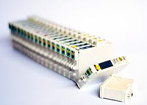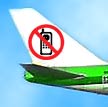While the One Laptop per Child (OLPC) project has taken on the aura of a charity – if you believe what you read in the mainstream media – the hard numbers tell a different story. Analysts say the component suppliers that have taken a gamble on the project stand a fair chance of coming out winners.
An obscure component like the rotating metal hinge that connects the OLPC's screen and keyboard costs only about $2.50, but with up to 10 million required this year, it could earn Taiwanese manufacturer, Shin Zu Shing Co, as much as $25 million in just six months. Similarly, Taiwanese keyboard manufacturer Sunrex will get about $3 from every OLPC sold with its sealed, rubber-membrane keyboard - for a possible $30 million.
Slim margins, massive scale
“Gross margin on components of OLPC notebooks will be slimmer, but this will be eased by the larger scale,” commented analysts at KGI Securities in Taipei in a recent investment briefing. Shares prices of several component makers have beaten the market in recent weeks as positive news about initial OLPC orders leaks out.
Taiwan is a critical junction on the OLPC manufacturing railroad. That's hardly a surprise, as Taiwan-based firms build a staggering 90 percent of the world's notebook PCs. These are the companies that have the ability, and the economies of scale, to actually make a profit supplying dirt cheap PCs to some of the word's poorest regions.
The OLPC foundation is a non-profit, and many people are contributing work on software and design. But, from the start, the OLPCs designers have built in a five to ten percent profit margin for manufacturers – betting that market forces can drive the price down faster than good intentions alone.
| $38 | CPU and Chipset | Design: AMD (US), Manufacture: TSMC (Taiwan) |
| $28 | LCD Screen and backlight | Chi Lin Technology (Taiwan) and Everlight (Taiwan) |
| $20 | Assembly, minor components | Quanta (Taiwan), with Shin Zu Shing/SZS, Realtek (Taiwan), etc |
| $12 | Case | Hon Hai (Taiwan) |
| $10 | Memory (128MB DDR DRAM) | Hynix, Samsung, Elpida (Korea) |
| $8 | Hard disk (512MB NAND Flash) | Samsung, Hynix (Korea) |
| $7 | Battery | Design: Simplo (Taiwan), Manufacture: BYD(China) |
| $5 | Wireless Internet module | Design: Marvell (US), Manufacture: TSMC (Taiwan) |
| $3 | Keyboard | Sunrex (Taiwan) |
| $2 | Audio, Keyboard/Control Chip | Design: ADI(US), ENE Tech (Taiwan), Manufacture: TSMC (Taiwan) |
| OLPC Component costs - Source: OLPC, KGI, TRI, Merrill Lynch (12/2006) |
The OLPC costs less than $150, a sum that wouldn't even buy a replacement battery for some conventional laptops. The price is low, but multiplied by the millions of units planned, the potential income soon climbs into the billions. Project leaders hope to put 5 to 10 million units into the hands of children during the second half of this year, and they say they have commitments to buy from governments in seven countries.
Barry Lam, Chairman of Taiwan's Quanta Computer, which will assemble the OLPC, has assured shareholders that it is not a charity project, and will generate profits - although some sources have claimed that Quanta will need to make 100 million before it sees a significant return.
“Is this goodwill or business? As our work with OLPC illustrates, it will not be successful unless it is both,” says AMD Chairman Hector Ruiz.
OLPC, the unseen Xmas gift?
Together with the potentially huge scale, a key attraction of the OLPC project for manufacturers is that it is not a seasonal business. Popular gadgets like PCs, notebooks and iPods, are seasonal. More consumer electronics are sold around Christmas than at any other time of the year. The busy Christmas season requires extra production capacity which is underused during the rest of the year.
The OLPC can take advantage of cheap, underutilized factory space during the first half of each year. Then, in late summer, when factories begin churning out products that will be sold around Christmas, manufacturers can switch those same production lines and staff back to making components for Apple, Dell and Lenovo. In a sense, one could say that West's Christmas shopping frenzy makes the OLPC possible, or at least subsidises a lower price.
However, in reality, it looks like delays in getting the first year's production started may have pushed some of the OLPC manufacturing and assembly back into the third quarter of 2007, putting extra pressure on some manufacturers at the busiest time of the year.
While the majority of the companies building the OLPC are based in Taiwan, much of the heavy lifting is taking place in China. For example, Quanta will assemble the laptop at one of its factories in China's Jiangsu province. However, more knowledge intensive work, like chip design and manufacture is mostly being handled by more skilled workers in Taiwan.










Moral choice
Isn't it wrong simply to make a profit from a charity for poor folks?
Why?
Why?
Profit = motive. Motivation drives innovation and investment.
The whole thing wouldn't get off the ground if there wasn't some scope for some profit.
it is understandable that in
it is understandable that in order to get suppliers on board the OLPC project, profit is a strong motive. but one must consider where these profits are coming from. some of it will be from some of the world's poorer countries. adding further debt to developing states as such in turn impacts other areas where spendature is needed.